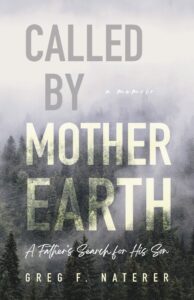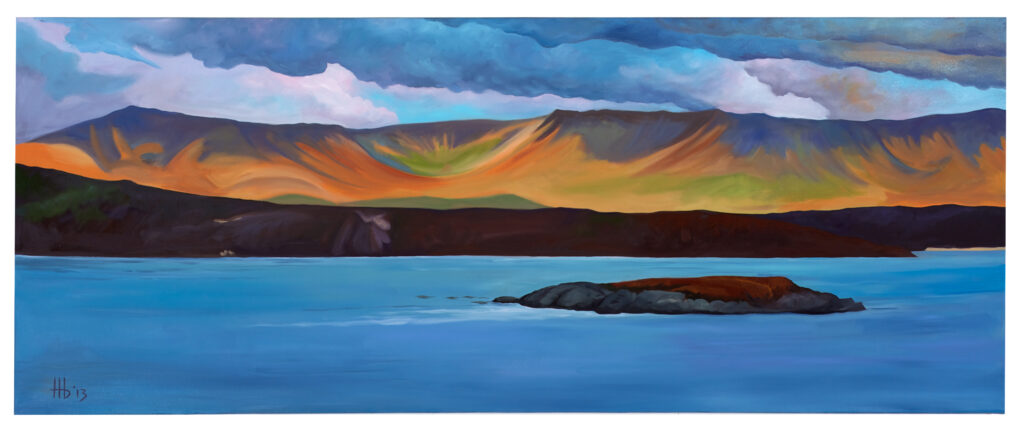“On the surface, this appears like a story about the search for Jordan. But it’s really about what we discovered while searching for him”
March 2024
On Thanksgiving weekend, 2020, Greg Naterer’s 25-year-old son, Jordan, was reported missing while hiking in Manning Park, BC; he was a graduate student in engineering at UBC. Called By Mother Earth is Naterer’s account of the next ten months’ search for his son.
I assume you kept meticulous contemporaneous details of the search, and had access to them for this account – but your own emotional responses play such an important role too. Did you keep a diary?
“A picture is worth a thousand words”. I kept photos from each hike every day. Afterwards I reflected on the group of photos for each day and then recounted the most memorable aspects of that day based on the photo(s). Each photo was filled with unforgettable memories. From a photo(s), I could easily remember what I was thinking, feeling, and smelling. Either it was a feeling of Jordan’s presence at a particular location, or an encounter with extreme terrain, a memorable exchange with my hiking partner, or something else that became fixed in my mind and memories forever. Imagine yourself looking back on a photo with a loved one some years ago. You will remember the experience well, down to the details of what was happening and how you were feeling when that photo happened.
I was struck by the sheer and vast logistics of this endeavour. You’re obviously a problem solver, and adept at developing new skills. What was the biggest physical or intellectual challenge for you?
The biggest challenge was the continual battle (psychologically and emotionally) with feelings of utter despair, negativity, and hopelessness. One the one hand, we would never give up, but on the other hand, neither I nor my family could risk a nervous breakdown. Keep in mind the sheer size of the mountain wilderness that needed to be searched. Manning Park itself was about 80,000 hectares (800 sq km), but the possible scenarios extended beyond only Manning Park, including the neighbouring Skagit Valley Park, and south across the Canada / US border. Jordan was physically fit and could have mistakenly veered off in several possible directions. From past studies of other lost hikers, it is possible to go around 10 km per day in the wilderness in the wrong direction. So I constructed maps with multiple 10 km segments in each direction, which led to seemingly an endless number of possible scenarios and directions.

I also felt that the grueling day-to-day hikes were actually also a physical way to process your fears and grief. Would you agree?
The hikes were grueling because they were often going off-trail along steep mountain slopes. Typically it was about 20 km per day on average, 5-6 days per week, and around 500 to 700 m of elevation change. During the winter, there was about 2-3 m of snow cover everywhere. I became proficient with snowshoeing and staying safe. But it was so physically exhausting that a hiking partner joked that I walked like a penguin after taking off my snowshoes! Somehow the physical exhaustion relieved the mental stress. I felt a sense of relief that I was giving Jordan everything that I could physically pull together. The mental anguish was worse during December and January after we returned back the first time to St John’s. Sitting at home while Jordan was still missing was unbearable. At least after I returned back to Manning Park in February, we had a plan of action to do everything possible to bring Jordan home.
You weave in so much context – botany, geology. And the psychology of being lost – I hadn’t realized this had been so much studied. What revelations did you find there?
Meditation, trees, and Indigenous ways of knowing are recurring themes in the book. Trees are social beings that work together. They share and nourish each other in ways similar to human communities. Instead of considering the surroundings as random trees and plants, I began to sense a nature spirit that held secrets of what happened to Jordan. Each stretch of terrain had its own personality, character, and moods. Some were compassionate and forgiving while others were cruel. I became more and more connected with nature. Nature was part of me and I was part of nature. The strategy to find Jordan became less about thinking and more about experiencing and feeling.
Did you anticipate your emotional responses to and experiences in the wilderness? Was that difficult for you to write ab out? In fact, was this a difficult book to write, or did it help you to rework the experience in text?
The Indigenous people of the Lower Similkameen Valley in British Columbia where Jordan was hiking use the word Tmxwulaxw or “Mother Earth” to describe the sacred life and forces that comprise the spirit of the natural world. This nature spirit is a central character in the book. I had not anticipated the wisdom that would be shared by Tmxwulaxw in our journey to find Jordan. Initially, I was reluctant to relive these experiences. It was certainly difficult to write about. But after my wife, Josie, and my two sisters-in-law, Karol and Yvonne, encouraged me to write a book, I decided to start the project. I could see that it would be a special way to keep Jordan in our hearts and create a lasting legacy for him. Once I began writing, it soon became a labour of love. Our search efforts were remarkable. I hope the strategies we used will be helpful to people facing a similar crisis, and our determination to find Jordan serves as an inspiration to follow your hearts and have courage even under the darkest of circumstances.
Is there anything else you’d like to tell us about this book?
On the surface, this appears like a story about the search for Jordan, after he didn’t return from a hiking trip. But it’s really about much more. It’s about what we discovered while searching for him. It’s a book about choices, and perseverance, and friendship, and learning. It’s a book about coming to terms with life and loss when terrible things happen. It’s a book about discovering what really matters when such things happen, and what doesn’t. About finding support and comfort in places you expect and in places that surprise you. It’s a book about dealing with tragedy – when it happens to you and when it happens to others. It’s a book about loving Jordan and losing him. It’s a book about sharing Jordan and saying goodbye to him again, for now. It’s a book about humanity—about trust, deceit, compassion, endurance, openness, judgement, love.
It’s my understanding that all proceeds of book sales are going towards a scholarship in Jordan’s name. Would you like to share information about this?
Proceeds of book sales will go towards the Jordan Naterer Memorial Scholarship in Engineering at Memorial University. Jordan was a graduate of Memorial’s engineering program in 2018. He was an NSERC Canada Graduate Scholarship holder and finished his Master’s degree in Electrical and Computer Engineering at the University of British Columbia in 2020. The scholarship embodies everything that is Jordan’s legacy – a Memorial University Electrical Engineering student who is academically strong and community involved.
The Canadian Canine Search Corps (CCSC) provided valuable assistance in our search for Jordan. Based in Calgary, CCSC does Search and Rescue work, looking for missing persons and human remains with specially trained teams of dogs. CCSC is a not-for-profit organization that provides services on a minimal cost recovery basis. The group offsets expenses through fundraising and public donations. All monies donated to CCSC go directly toward helping to find and recover the lost and missing to bring closure to their loved ones. You can learn more at www.caninesearchcorps.com. Please consider making a donation to CCSC.
Called By Mother Earth is published by Breakwater Books ($24.95)
(Image: Lightning Lake in Manning Park, Wikimedia Commons.)



